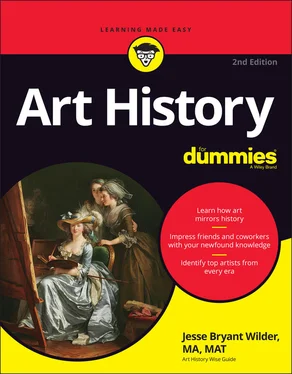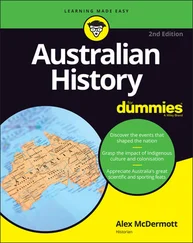Jesse Bryant Wilder - Art History For Dummies
Здесь есть возможность читать онлайн «Jesse Bryant Wilder - Art History For Dummies» — ознакомительный отрывок электронной книги совершенно бесплатно, а после прочтения отрывка купить полную версию. В некоторых случаях можно слушать аудио, скачать через торрент в формате fb2 и присутствует краткое содержание. Жанр: unrecognised, на английском языке. Описание произведения, (предисловие) а так же отзывы посетителей доступны на портале библиотеки ЛибКат.
- Название:Art History For Dummies
- Автор:
- Жанр:
- Год:неизвестен
- ISBN:нет данных
- Рейтинг книги:3 / 5. Голосов: 1
-
Избранное:Добавить в избранное
- Отзывы:
-
Ваша оценка:
- 60
- 1
- 2
- 3
- 4
- 5
Art History For Dummies: краткое содержание, описание и аннотация
Предлагаем к чтению аннотацию, описание, краткое содержание или предисловие (зависит от того, что написал сам автор книги «Art History For Dummies»). Если вы не нашли необходимую информацию о книге — напишите в комментариях, мы постараемся отыскать её.
Art History For Dummies
Art History For Dummies
Art History For Dummies
Art History For Dummies — читать онлайн ознакомительный отрывок
Ниже представлен текст книги, разбитый по страницам. Система сохранения места последней прочитанной страницы, позволяет с удобством читать онлайн бесплатно книгу «Art History For Dummies», без необходимости каждый раз заново искать на чём Вы остановились. Поставьте закладку, и сможете в любой момент перейти на страницу, на которой закончили чтение.
Интервал:
Закладка:
If we know who we were 3,000 years ago during the Mesopotamian period or the Egyptian period, we have a better sense of who we are today. Mesopotamian art is usually macho war art, propaganda art, or religious and tomb art. Egyptian art was nearly all tomb art — art to lead the dead into a cozy afterlife without snags. By learning to read Mesopotamian and Egyptian art, we also learn about how they influenced later cultures, especially the Ancient Greeks and Romans, and in turn, how the Greeks and Romans (and others) still influence, guide, and inspire us today.
Ancient Greek period (c. 850 BC–323 BC) and Hellenistic period (323 BC–32 BC)
Because of the conquests of Alexander the Great (356 BC–323 BC) and the later Roman love affair with Greek culture, the art produced in the city-states of Ancient Greece spread from the British Isles to India, changing the world forever. Even studying a few Ancient Greek vases can reveal a lot about our times — if you know how to read the vases. Many Greek vases show us what Ancient Greek theater looked like; modern theater and cinema are the direct descendants of Greek theater (see Chapter 7). Greek vases depict early musical instruments, dancers dancing, and athletes competing in the ancient Olympics, the forerunner of the modern Olympic Games. Some vases show us the role of women and men: Women carry vases called hydrias; men paint those vases. Modern gender roles are still affected, and in some cases driven, by ancient ones.
 The Greeks invented techniques like red-figure painting, the contrapposto pose (in which a human figure stands gracefully at ease with most of its weight on one foot), and perspective to enable artists to represent the world realistically (see Chapter 7). But as real looking as classical Greek art is, it is also idealized (made to look better than real life). Greek statues don’t have pot bellies or receding hairlines. Art of the classical period (when Greek art peaked) is known for its otherworldly calm and beauty. The Hellenistic period (the extension of Greek culture via the conquests of Alexander the Great) added realism and emotion to the Greek’s art palette.
The Greeks invented techniques like red-figure painting, the contrapposto pose (in which a human figure stands gracefully at ease with most of its weight on one foot), and perspective to enable artists to represent the world realistically (see Chapter 7). But as real looking as classical Greek art is, it is also idealized (made to look better than real life). Greek statues don’t have pot bellies or receding hairlines. Art of the classical period (when Greek art peaked) is known for its otherworldly calm and beauty. The Hellenistic period (the extension of Greek culture via the conquests of Alexander the Great) added realism and emotion to the Greek’s art palette.
Roman period (300 BC–AD 476)
The Romans and their predecessors on the Italian peninsula, the Etruscans, both copied the Greeks. But art historians don’t call the Roman period a Greek replay. The Romans didn’t merely imitate — they added on to the Greek style, often replacing idealism with realism. The busts and statues of Roman senators and emperors can look tough, chubby, and even pockmarked.
 In architecture, the Romans contributed the Roman arch, an invention that helped them to build the biggest system of roads and aqueducts the world has ever seen.
In architecture, the Romans contributed the Roman arch, an invention that helped them to build the biggest system of roads and aqueducts the world has ever seen.
Did the Art World Crash When Rome Fell, or Did It Just Switch Directions?
Art definitely changed course in the West with the exponential rise of Christianity during the last phase of the Roman Empire and in the East and South with the birth and rapid growth of Islam in the seventh and eighth centuries.
Byzantine period (AD 500–AD 1453)
Byzantine art — a marriage of Roman splendor, Greek art styles, and Christian subject matter — flourished in the Eastern Roman Empire after the fall of Rome in AD 476. But Byzantine art is less naturalistic than the Greek and Roman art that inspired it. It points to the hereafter rather than the here and now.
The most popular Byzantine art form was icon painting. Icons (holy images of Jesus, Mary, and the saints) were used in prayer. Byzantine artists also worked in mosaic (pictures made from pieces of cut glass).
Islamic period (seventh century+)
Islamic art and architecture spread across the Near East, North Africa, and Spain following the wave of Islamic conquests between AD 632 and AD 732. Like Moses, Mohammed condemned graven images, so there aren’t many representations of people in Islamic art. Instead, Islamic artists created astoundingly intricate patterns in carpets, manuscripts, and architecture.
Medieval period (500–1400)
 Medieval art is mostly Christian art created in Europe between Rome’s fall and the Renaissance. Its art forms include stained-glass windows, illuminated manuscripts, reliquaries (containers for holy relics — the bones and clothes of saints), architectural reliefs, and Romanesque and Gothic cathedrals.
Medieval art is mostly Christian art created in Europe between Rome’s fall and the Renaissance. Its art forms include stained-glass windows, illuminated manuscripts, reliquaries (containers for holy relics — the bones and clothes of saints), architectural reliefs, and Romanesque and Gothic cathedrals.
Throughout the Middle Ages, art and architecture had a spiritual mission: to direct people’s attention toward God. Churches soared in that direction, and sculpture and paintings pointed the way to paradise. They depicted the sufferings of Christ, the Apostles, martyrs, the Last Judgment, and so on. Humans’ physical features mattered less to medieval artists than their spiritual struggles and aspirations. So they tended to represent people more symbolically than realistically.
High Renaissance (1495–1520) and Mannerism (1530–1580)
During the Renaissance, humankind’s spiritual focus shifted again. You could say that the people of the Renaissance had a double vision: Educated men and women wore mental bifocals so that they could see close up (earthly things) and far away (heaven). With this double vision, Renaissance artists celebrated both humans and God without short-changing either.
The close-up focus allowed realism to make the comeback we call the Renaissance: humans reclaiming their classical (Greek and Roman) heritage (see Chapters 11and 12).
Baroque period (1600–1750) and Rococo period (1715–1760s)
The Reformation split Christianity down the middle, unleashing a maelstrom of religious wars between Catholics and Protestants and nearly 200 years of intolerance. To recover what lost ground it could, the Catholic Church launched the Counter-Reformation in the middle of the 16th century. One critical Counter-Reformation weapon was religious art that reaffirmed Catholic values while rendering them more people friendly. Baroque saints shed the idealistic luster they had during the Renaissance and began to look like working-class folk — the class the Church was trying to hold on to.
Baroque art and architecture are characterized by grandiose decoration, dramatic lighting, and theatrical gestures that reach out to viewers, mixed with earthy realism. Rococo art dropped the drama of Baroque art and most of the religion while taking Baroque’s ornamental side to extremes.
In the Machine Age, Where Did Art Get Its Power?
Many 18th- and 19th-century artists rejected, criticized, or ignored the Industrial Revolution. Instead of uplifting humankind, industry seemed to demoralize and dehumanize people. Men, women, and children were forced to work 14 hours a day, 6 days a week in urban factories, without benefits or vacations. Factories polluted the cities, alienated people from the soil, and seemed to benefit only those who owned them. This led many artists to turn to nature or the past or to a make-believe Golden Age when life was beautiful and just. It provoked others to try to reform society through their art. Neoclassicism and Romanticism occurred during the Enlightenment and the American, French, and Industrial Revolutions.
Читать дальшеИнтервал:
Закладка:
Похожие книги на «Art History For Dummies»
Представляем Вашему вниманию похожие книги на «Art History For Dummies» списком для выбора. Мы отобрали схожую по названию и смыслу литературу в надежде предоставить читателям больше вариантов отыскать новые, интересные, ещё непрочитанные произведения.
Обсуждение, отзывы о книге «Art History For Dummies» и просто собственные мнения читателей. Оставьте ваши комментарии, напишите, что Вы думаете о произведении, его смысле или главных героях. Укажите что конкретно понравилось, а что нет, и почему Вы так считаете.












